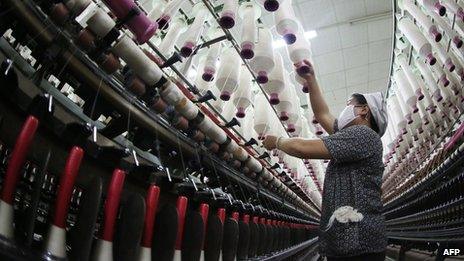Can Asian economies fuel Asia's growth?
- Published

There have been fears that a global slowdown may hurt Asia's export-dependent economies
Asian nations, led by China, have become the key driver of global economic growth in recent years.
But despite their robust performance, there has always been an element of doubt attached to their success.
Critics have warned that they are too dependent on demand from the west, the US and Europe in particular, to drive their growth.
The fear has been that as growth in the US and Europe slows, Asia's export-led economies will suffer as well.
But things may be starting to change.
"This is the era of Asian-consumption led global growth," says Shaun Rein, managing director of China Market Research Group.
"From a region wanting to be an economic superpower, Asia has become one. It now rivals the US in terms of global economic and trade influence," he adds.
'Big readjustment'
And this is the reason why analysts are backing the Asian consumers.
According to China's Foreign Minister Yang Jiechi, China's trade with Asian countries is now more than its trade with the US and Europe.
Beijing's trade with its neighbours rose to $1.2 trillion (£800bn) in 2012 - $120m more than its combined trade with the European Union (EU) and the US.
There are a number of factors behind the trend, not least the rise of China as a consumer of goods and raw materials.
China's economic growth in recent years, which has seen it become the world's second-largest economy, has been accompanied by the emergence of a more affluent middle class.
Rising income levels have resulted in a rise in domestic consumption, boosting demand for imports for items ranging from cars to electronic goods.
At the same time, big infrastructure projects, another key driver of China's growth, have driven up demand for raw materials from resource-rich countries such as Indonesia.
"If you look at the Asian exports, there has been quite a big readjustment in the markets," says Rajiv Biswas, chief economist for Asia-Pacific at IHS Global Insight.
"The rise of China in the last ten years has done a great deal to reduce Asia's dependency on the EU and the US."
Mr Biswas adds that the trend is likely to continue over the next decade as China's economy is forecast to grow at a faster pace than that of the US and EU.
Asian demand
And it is not just China that has seen a jump in domestic demand.
Other countries in the region such as Indonesia, the Philippines and Thailand have also seen domestic consumption rise in recent times.
Analysts say that demand in these economies has been boosted in part by rising income levels, and also by attempts by policymakers to sustain growth amid global economic problems.
They say that as the global financial crisis and the eurozone's debt issues hurt global demand in recent years, many of the economies in Asia eased their policies to help stoke domestic consumption to sustain growth.
"It [the slowdown in global demand] forced a lot of Asian economies to look inwards," says Rahul Bajoria, an economist with Barclays.
Mr Bajoria explains that rising consumption in these countries is helping drive up demand for intra-Asian exports.
"Given the linkages between these economies, they are basically feeding into each other's growth," he says.
'Another locomotive'
Mr Bajoria's comments are backed by the trade figures of the Association of Southeast Asian Nations (Asean), a 10-member bloc which includes the Philippines, Indonesia, Singapore and Thailand.
According to its latest figures, external, more than 50% of its total trade in 2011 took place within the Asean member nations or with China, Japan and South Korea.
The US and EU accounted for less than 25% share.
And analysts project Asean to be an even bigger driver of regional growth in the coming years.
IHS Global Insight has forecast the combined gross domestic product (GDP) of the ASEAN bloc to rise from $2.3 trillion in 2012 to $10 trillion by 2030.
"Asean will become another locomotive of Asian growth," says IHS Global Insight's Mr Biswas.
At the same time, some analysts point to another trend which they say is playing a key role in driving consumer demand in other, relatively smaller Asian nations.
"As wages rise in China, many companies are setting up factories in other countries such Vietnam and Cambodia," explains Mr Rein of the China Market Research Group.
Mr Rein explains that as firms set up facilities in those countries, more people are finding new and in some cases better-paying jobs.
"That is creating a whole new middle class in those countries, with more disposable incomes," he says.
Potential risks
But along with these opportunities there are also risks to intra-Asian trade, not least from the geo-political tensions among the region's biggest economies.
Relations between China and Japan have soured in recent months as they spar over a set of disputed islands in the East China Sea.
Last year, as tensions over the dispute mounted, there were anti-Japanese protests in China, which hurt sales of Japanese goods in China and impacted on bilateral trade.
Analysts warn that any further escalation of the rift may hurt trade between the two countries, which is worth about $345bn per year, again.

Anti-Japan demonstrations in China last year hurt bilateral trade
There are also other potential conflicts, such as tensions between South and North Korea, and between China and the Philippines, which analysts say may hurt regional stability if they flare up.
"There are fault lines emerging in the political situation in various countries," says Mr Biswas of IHS Global Insight.
"A lot of Asia's future momentum will depend on stronger regional political co-operation."
At the same time, analysts say that while the region's economies have become less dependent on the US and EU, they have become increasingly reliant on China.
They warn that a sharp slowdown in the Chinese economy was likely to have a big impact on the region's overall growth.
There had been fears of a big decline in China's growth last year. While those fears have abated for now, analysts say it is a threat that nations need to be wary of.
"It is a fairly minimal risk, but it is a risk you have to account for," says Mr Rein of China Market Research Group.
- Published8 March 2013
- Published5 March 2013
- Published18 January 2013